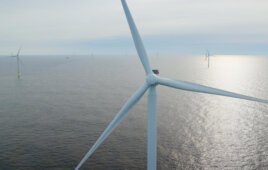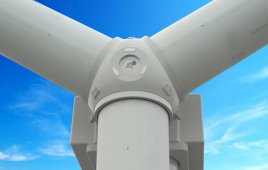
The airfoil is of a NASA/GTRI 2D CFD validation model, not necessarily the cross section of a turbine blade. Slots could be at the leading or trailing edges, depending on a required effect. A few slot dimensions are shown. Source: NASA.
An idea originally developed to increase the lift of slow moving aircraft wings and simplify helicopter rotors may soon improve the efficiency of wind turbine rotors and possibly reduce their manufacture costs. The aerodynamic idea of “circulation control” releases compressed air from narrow slots on the trailing edges of wings or hollow blades to change their aerodynamic properties. In aircraft, circulation-control wings increase lift, letting Navy aircraft fly at the slow speeds necessary for landing on an aircraft carrier, as well as take-off and land in shorter distances. In helicopter blades, the technique might simplify the rotor and its controls, and produce more lift.
The idea could also let wind turbines produce significantly more power than current blades at the same wind speed, 30 to 40% more by some calculations.
Research aimed at adapting circulation control to wind-turbine blades will be conducted by PAX Streamline, Novato, Calif., in collaboration with the Georgia Institute of Technology. A two-year project will lead to the construction of a demonstration pneumatic wind turbine with support from a $3 million grant from the Advanced Research Projects Agency-Energy, the federal energy research and development organization.
“Our goal will be to make the generation of electricity from wind turbines less expensive by eliminating the need for the complex blade shapes and mechanical control systems used in existing turbines,” says Robert J. Englar, principal research engineer at the Georgia Tech Research Institute. “Because these new blades would operate effectively at lower wind speeds, we could potentially open new geographic areas to wind-turbine use. The blown technology should also allow safe operation at higher wind speeds and in wind gusts that previously would shut down existing turbines to prevent damage”. And because the new blades would produce more aerodynamic force, torque, and power than comparable blades, these blown structures may allow reducing the size of the wind turbines. Together, these advances could significantly expand the generation of electricity from wind power in the U.S.”
The project will apply to controlling the aerodynamic properties of wind-turbine blades, which now must be made in complicated shapes and controlled by complex mechanisms to extract the most power from the wind.
The big question awaiting study is how much energy will be required to produce the compressed air needed by blown blades. Preliminary studies by Professor Lakshmi Sankar in Georgia Tech’s School of Aerospace Engineering suggest that wind turbines with blades described here could produce 30 to 40% more power than conventional turbines at the same wind speed, when the energy required to produce the compressed air is subtracted from the total energy production. The new turbine blades will be developed at Georgia Tech’s low-speed wind tunnel research facility in Cobb County, north of Atlanta. “This grant will let us accelerate our research program, and within the next two years, deploy a prototype wind turbine which demonstrates this game-changing technology,” says PAX CEO John Webley. WPE
Filed Under: Blades, Projects




